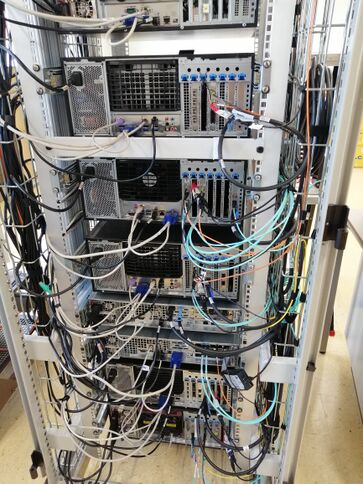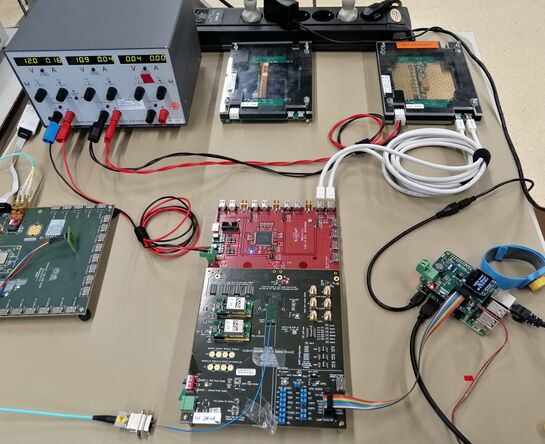Difference between revisions of "DAQ systems"
m (add link back to the EC homepage has been re-writen to be the same as in the other pages) |
m (add captions to pictures and re-arrange first paragraph) |
||
| Line 1: | Line 1: | ||
[[ITk Endcap Homepage|''Back to ITk End-cap Homepage'']] | [[ITk Endcap Homepage|''Back to ITk End-cap Homepage'']] | ||
| − | FELIX is one of the main components of the new ATLAS TDAQ architecture. This DAQ system will be installed in all the ATLAS sub-detectors in Run 4. At Nikhef, a setup has been assembled in lab N221 with the purpose of training before petal arrival. In this setup, shown below, Phase-I FELIX (FLX-712) is used. Due to the lack of petals at the time, the sensor is an old barrel module with one ABC chip and one HCC chip, but no sensing material and no AMAC chip (there is a wire bond in its place to provide power). The VLDB+ with the Nikhef adapter board substitutes the EoS board, since the module has no AMAC chip, there is no external connection between the VLDB+ and the Nikhef adapter board, but whenever we use a module with it, we will need to connect them through a mini-HDMI cable. The lpGBT on the VLDB+ is not efused. For more information about this training setup, you can contact Andrea García Alonso ([[Mailto:agarciaa@cern.ch|agarciaa@cern.ch]]). | + | FELIX is one of the main components of the new ATLAS TDAQ architecture. This DAQ system will be installed in all the ATLAS sub-detectors in Run 4. |
| − | [[File:Nikhef FELIXservers 20220517 electronics dep Back-2.jpg|none|thumb|484x484px]] [[File:FELIXsetup september22-2.jpg|none|thumb|545x545px]] | + | |
| + | At Nikhef, a setup has been assembled in lab N221 with the purpose of training before petal arrival. In this setup, shown below, Phase-I FELIX (FLX-712) is used. Due to the lack of petals at the time, the sensor is an old barrel module with one ABC chip and one HCC chip, but no sensing material and no AMAC chip (there is a wire bond in its place to provide power). The VLDB+ with the Nikhef adapter board substitutes the EoS board, since the module has no AMAC chip, there is no external connection between the VLDB+ and the Nikhef adapter board, but whenever we use a module with it, we will need to connect them through a mini-HDMI cable. The lpGBT on the VLDB+ is not efused. | ||
| + | |||
| + | For more information about this training setup, you can contact Andrea García Alonso ([[Mailto:agarciaa@cern.ch|agarciaa@cern.ch]]). | ||
| + | [[File:Nikhef FELIXservers 20220517 electronics dep Back-2.jpg|none|thumb|484x484px|alt=|FELIX servers in Nikhef lab N221. Used for FELIX development and tests. Canche is the third from the bottom, used for lab tests when getting familiar with FELIX. None is the ITk-server used for petal reception/testing]] [[File:FELIXsetup september22-2.jpg|none|thumb|545x545px|alt=|FELIX setup in lab N221 at Nikhef (September 2022). At that time, it was connected to the FELIX server called canche, later on this would change to the ITk server that arrived from CERN in November that year. The module for test is an old barrel module without sensing material]] | ||
Revision as of 09:57, 10 February 2023
FELIX is one of the main components of the new ATLAS TDAQ architecture. This DAQ system will be installed in all the ATLAS sub-detectors in Run 4.
At Nikhef, a setup has been assembled in lab N221 with the purpose of training before petal arrival. In this setup, shown below, Phase-I FELIX (FLX-712) is used. Due to the lack of petals at the time, the sensor is an old barrel module with one ABC chip and one HCC chip, but no sensing material and no AMAC chip (there is a wire bond in its place to provide power). The VLDB+ with the Nikhef adapter board substitutes the EoS board, since the module has no AMAC chip, there is no external connection between the VLDB+ and the Nikhef adapter board, but whenever we use a module with it, we will need to connect them through a mini-HDMI cable. The lpGBT on the VLDB+ is not efused.
For more information about this training setup, you can contact Andrea García Alonso ([[1]]).
How to connect to FELIX: Follow these FELIX instructions !!!!
To run scans, the necessary repositories are:
https://gitlab.cern.ch/itk-strips-at-sr1/scan-tools-for-yarr/-/tree/EC-Freiburg
https://gitlab.cern.ch/arnaez/YARR/-/tree/devel_SR1
Useful links I gathered during the first months working with the FELIX system:
- The ATLAS FELIX project webpage
- https://atlas-project-felix.web.cern.ch/atlas-project-felix/
- FELIX manual latest version
- https://atlas-project-felix.web.cern.ch/atlas-project-felix/dev/staging/www/user/felix-user-manual/versions/Latest/
- ATLAS FELIX lab (also called playground) at Nikhef
- https://redmine.nikhef.nl/et/projects/atlas-felix/wiki/Atlas_setup_in_H148
- Latest FELIX Phase II PDR indico page (status and introduction of the software, hardware and test activities)
- https://indico.cern.ch/event/1108368/
- TTC specs on edms
- https://edms.cern.ch/document/2379978/1
- For further reading about timing, trigger and control
- relevant page in the TDAQ phase II TDR: https://cds.cern.ch/record/2285584/files/ATLAS-TDR-029.pdf#page=105
- LPGBT webpage
- https://lpgbt.web.cern.ch/lpgbt/
For access to the lpgbtv1 manual, subscribe to lpgbt-users@cern.ch egroup
Other egroups (meetings, information, updates etc): atlas-tdaq@cern.ch, atlas-tdaq-software@cern.ch, atlas-tdaq-felix-users@cern.ch, atlas-tdaq-felix-developers@cern.ch
- Tests at CERN SR1
- https://twiki.cern.ch/twiki/bin/viewauth/Atlas/FelixStripsTestsAtSR1, https://twiki.cern.ch/twiki/bin/viewauth/Atlas/FelixStripsTestsAtSR1#lpGBT_configuration_with_VLDB
- Twiki page of the DAQ Demonstrator
- https://twiki.cern.ch/twiki/bin/viewauth/Atlas/HGTDDaqDemonstratorEMU
- FELIX Software for testing
- https://gitlab.cern.ch/itk-felix-sw/itk-felix-sw/-/blob/master/Readme.md

